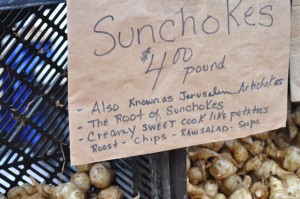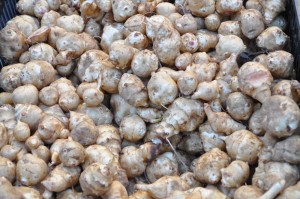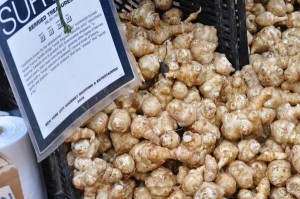Sunchokes are our new obsession. They’re sweet and crispy raw and roast up nicely. Erik eats one or two almost every day in his lunchtime salad.
Background:
Sunchokes, a.k.a. Jerusalem artichokes, are the roots of a species of sunflower. They were discovered by the western world in 1605 by Samuel Champlain, a French explorer, who initially compared the taste to an artichoke. I’m not sure why though…I don’t taste it. The “Jerusalem” piece of the name is thought to have come from the Italian word “girasole”, meaning sunflower. A rebranding strategy in the 1960s renamed them sunchokes. Twenty years later, the poor sunchoke was involved in a pyramid scheme involving farmers who believed the sunchoke was about to make it big.
Sunchokes look like small potatoes, but are gnarlier and more twisted. They’re also lighter than they look, so a pound stretches pretty far.
Selecting Sunchokes:
Look for the same qualities you look for when selecting potatoes or carrots. They should be firm and dry. The larger sunchokes are easier to peel, which is optional in my opinion.
Benefits of Sunchokes:
- Pretty good source of potassium, iron, fiber, niacin, thiamine, phosphorus and copper
- Local substitute for water chestnuts
One word of caution: Sunchokes contain inulin, rather than starch, which some people don’t digest well. Neither Erik nor I have ever had a problem.
Basic Preparation:
Give them a good scrub. Then slice them thinly for salads, roast them, or steam them.
Starter Recipes:
This salad is a great way to try a bunch of different root vegetables raw. You could slice them thinly or use a vegetable peeler to create strips. We made it a few weeks ago and will have to make it again soon.
Here are a few cooked dishes that look pretty tasty.
Sources:
Local Harvest
Wikipedia



